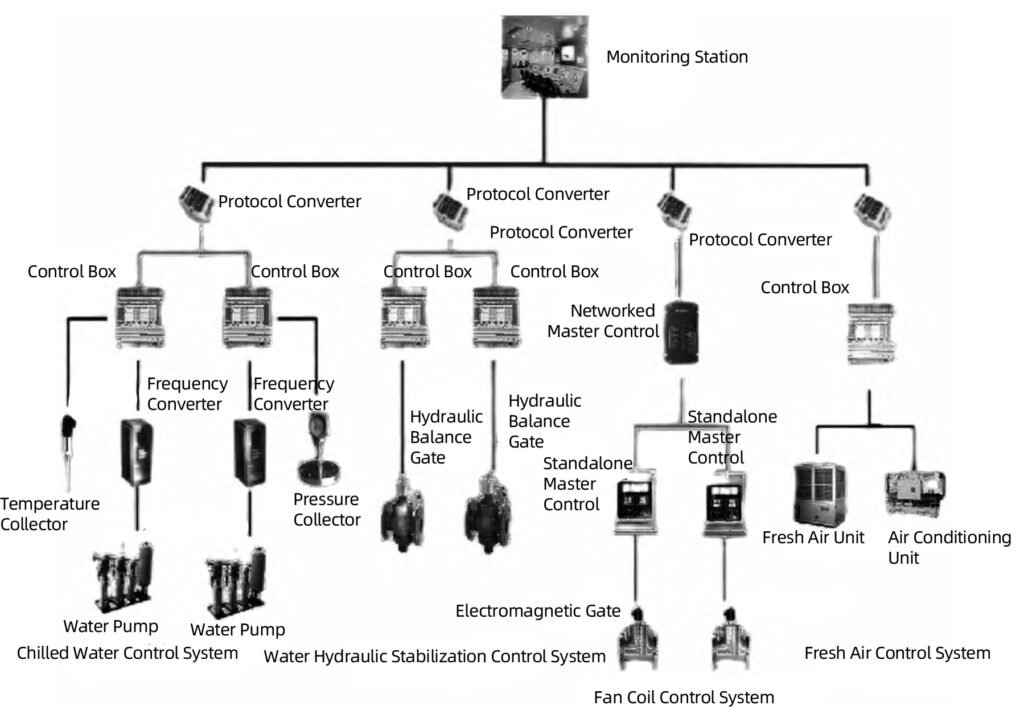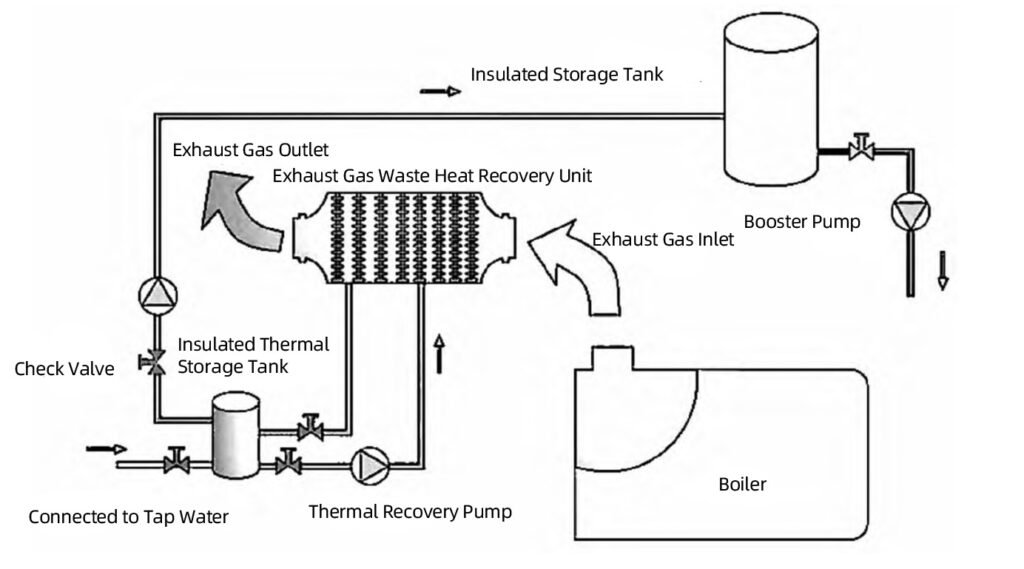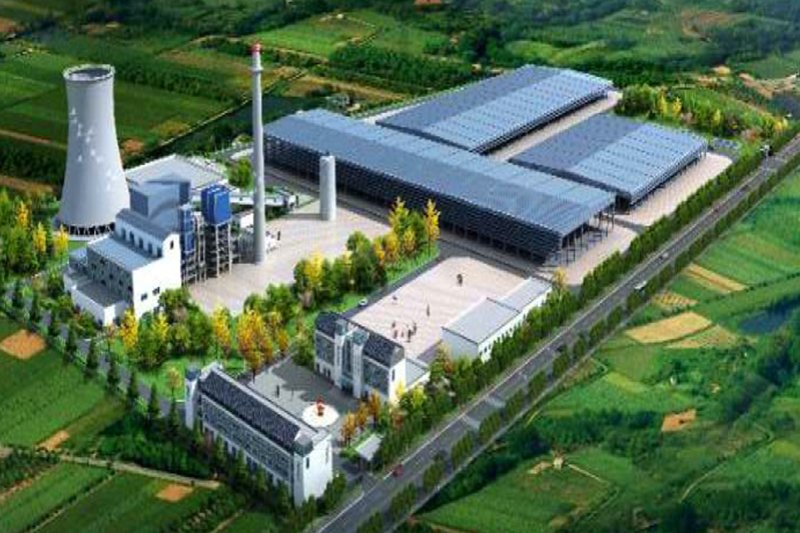This paper delves into the critical examination of energy-saving retrofit measures for power plant boilers, with the dual objectives of enhancing energy utilization efficiency and mitigating environmental impact. A thorough analysis has been conducted, taking into account the significance of such retrofits, the various influencing factors, and the practical steps that can be implemented. The study puts forth a comprehensive set of recommendations designed to drive energy conservation within the context of boiler operations.
Addressing key factors that include boiler specifications and operational parameters, the level of automation, the performance of equipment insulation, economic considerations, and the caliber of personnel, the paper suggests targeted retrofit measures. These encompass the adoption of sophisticated combustion technologies, enhancements to waste heat recovery systems, and the streamlining of boiler operation management. Additionally, strategies for the substitution of traditional energy sources with cleaner alternatives and initiatives to bolster the energy-saving consciousness and proficiency of the workforce are discussed. The collective impact of these measures is anticipated to yield substantial benefits in guiding power plants towards more sustainable and economical energy use, aligning with global efforts to reduce emissions and environmental footprints.
Power plants, as primary units of energy supply, play a significant role in the economic and social development. However, the issues of energy consumption and pollution emissions from power plants are becoming increasingly prominent, causing a severe impact on the environment. Therefore, implementing energy-saving retrofits for power plant boilers is an urgent task to improve energy utilization efficiency and protect the environment.
The Importance of Power Plant Boiler Energy-saving Retrofits
As an essential device for energy conversion, the energy efficiency of power plant boilers is directly related to the overall energy utilization efficiency of the power plant. With the increasing severity of energy scarcity and environmental pollution, energy-saving retrofits have become particularly urgent. Through retrofits, the energy consumption of power plant boilers can be effectively reduced, and the power generation efficiency can be improved. Advanced energy-saving technologies and equipment can optimize the combustion process and improve the thermal energy recovery system, reducing energy waste and loss. This not only helps to reduce the operating costs of the power plant but also enhances power generation efficiency and strengthens the competitiveness of the power plant. At the same time, energy-saving retrofits of power plant boilers contribute to reducing the dependence on non-renewable energy sources and promoting the optimization of the energy structure. Introducing clean energy sources such as wind and solar energy to replace traditional high-emission energy sources like coal helps to achieve green and low-carbon development, laying a solid foundation for sustainable development. This not only helps to protect limited non-renewable resources but also reduces greenhouse gas emissions, actively responding to global climate change initiatives. The internal structure of the power plant boiler is shown in Figure 1.

Note: 1 is the head, 2 is the shell, 3 is the stay, 4 is the rear tube plate, 5 is the fire tube, 6 is the rear smoke box, 7 is the throat, 8 is the handhole, 9 is the lower foot ring, 10 is the furnace door, 11 is the furnace belly, 12 is the front smoke box, 13 is the front tube plate, 14 is the chimney, 15 is the manhole.
Figure 1 Schematic diagram of the internal structure of the power plant boiler
In addition, energy-saving retrofits of power plant boilers are also an important measure to protect the environment. Optimizing the operation and management of the boiler, improving energy utilization efficiency, and reducing emissions contribute to reducing the emission of air pollutants, improving air quality, and protecting the ecological environment. This is of great significance for urban environmental management and people’s health. As the main production and consumption unit of energy, the energy-saving retrofits of power plants not only demonstrate the power industry’s exemplary effect but also provide a beneficial reference for energy-saving and emission reduction efforts in other industries.
2 Influencing Factors of Power Plant Boiler Energy-saving Retrofits
2.1 Specifications and Operating Parameters
The specifications and operating parameters of power plant boilers are key considerations for energy-saving retrofits. Boilers with different specifications and operating parameters show significant differences in combustion efficiency, energy utilization efficiency, and energy-saving potential. Older boiler designs often have some irrational aspects, leading to relatively low combustion efficiency, significant heat loss, and energy waste. In contrast, newer boiler designs use more advanced technologies to convert fuel into electrical energy more efficiently, improving power generation efficiency and reducing energy consumption and pollution emissions. Boiler operating parameters also affect energy-saving retrofits. Larger-capacity boilers typically have higher capacities but may have excessive energy loss during operation. Reasonably adjusting boiler operating parameters, such as steam temperature, pressure, and fuel supply, can ensure the boiler operates at its best state, improving energy utilization efficiency.
Therefore, for power plants with older boilers, upgrading the specifications and models is an important energy-saving retrofit measure. Introducing more efficient new boilers can significantly improve power generation efficiency, reduce energy consumption, and lower pollution emissions [3]. At the same time, regular inspection and maintenance of existing boilers to ensure they operate at their best state is also a key step in maintaining high energy utilization efficiency. The reasonable use of modern monitoring and automation technology to monitor boiler operation status in real-time and precisely control the combustion process helps to minimize energy waste.
2.2 Automation Level
Highly automated boilers can achieve precise control and optimized operation, directly affecting their operational stability and energy-saving effects. Boilers with a high level of automation can be automatically adjusted through intelligent control systems. Advanced control technologies and sensors can monitor various operating parameters of the boiler in real-time, automatically adjusting key parameters such as the combustion process, water supply, and air volume, ensuring the boiler operates under optimal conditions. In contrast, traditional manual adjustment methods are prone to human error and reliance on experience, which may lead to energy waste and unstable operation. Highly automated boilers can achieve intelligent fault diagnosis and early warning. When a boiler malfunctions or encounters abnormal conditions, the automated system can detect problems in a timely manner and respond accordingly, providing early warnings to prevent further expansion of faults and greater losses. This helps to ensure the stable operation of the boiler while reducing additional energy consumption caused by faults. In addition, highly automated boilers can achieve intelligent energy-saving control. Through precise data analysis and algorithm optimization, they can reduce heating temperature and fuel consumption while ensuring the boiler’s heating load, achieving energy-saving effects. The automated system can also automatically adjust operating modes according to seasonal and load changes, further improving energy utilization efficiency. Figure 2 shows the boiler’s automated control system diagram.

2.3 Equipment Insulation Performance
The insulation performance of the boiler directly affects energy loss. A well-insulated boiler can effectively reduce heat dissipation, thereby reducing energy consumption and improving energy utilization efficiency. Improving the boiler’s insulation performance has become an important direction in the energy-saving retrofit process. By using advanced insulation materials and technologies, heat radiation and convection heat dissipation on the boiler surface can be effectively reduced, thereby reducing heat loss. Insulation materials should have good thermal insulation properties while being able to resist moisture and corrosion, ensuring long-term stable insulation effects. In addition, the rational design of the boiler’s insulation structure and thickness is also crucial to ensure optimal insulation effects.
2.4 Economic Factors
Economic factors play an important role in energy-saving retrofits. Implementing energy-saving retrofits requires corresponding costs, including the expenses for retrofit equipment, introduction of new technologies, personnel training, etc. [4]. Therefore, power plants must conduct economic assessments and cost-benefit analyses before carrying out energy-saving retrofits to ensure the economic feasibility of the retrofit measures. In the economic assessment, power plants need to consider the input required for the retrofit and the expected energy-saving effects comprehensively, assessing the payback period and return on investment of the retrofit project. At the same time, it is necessary to consider not only the short-term energy-saving benefits but also long-term operational cost savings. Although energy-saving retrofits require some initial investment, over time, the saved energy costs and operational expenses will gradually offset these inputs. The results of the economic assessment and cost-benefit analysis will determine the feasibility and priority of energy-saving retrofits. With limited resources, power plants need to make priority choices based on actual conditions and the availability of funds.
2.5 Personnel Quality
The quality of personnel is crucial for the energy-saving retrofit of power plant boilers. The retrofit process requires the full support and participation of technical personnel, and their level and professional knowledge are directly related to the quality and efficiency of the retrofit work. Personnel with higher energy-saving technical levels can better understand and apply advanced energy-saving technologies, providing customized energy-saving retrofit plans for different boiler characteristics [5]. They can accurately analyze the energy consumption structure and problems of existing boilers and propose effective solutions to minimize energy loss and achieve energy-saving goals. In addition, personnel with professional knowledge can quickly identify and resolve technical issues that may arise during the retrofit process, avoiding unnecessary delays and additional cost inputs.
They can efficiently organize construction and commissioning work during the retrofit process, ensuring the smoothimplementation of retrofit measures and reducing project risks.
Specific Measures for Power Plant Boiler Energy-saving Retrofits
3.1 Introduction of Advanced Combustion Technology
New combustion technologies improve the combustion system and control technology to achieve more complete combustion, reducing fuel consumption and the production of emissions, thereby reducing energy waste and environmental pollution. Optimized combustion chambers and control technologies enhance combustion efficiency, reduce energy loss from unburned fuel, and lower the emission of harmful gases. Moreover, advanced combustion technologies can improve boiler operation stability, shorten downtime for maintenance, increase equipment utilization rates, and further enhance the economic benefits of power plants. Introducing advanced combustion technologies is an important and effective strategy in the energy-saving retrofit of power plant boilers. By continuously innovating and introducing technology, power plants can achieve energy-saving and emission-reduction goals, contributing positively to sustainable development, and achieving a win-win in energy utilization and environmental protection.
3.2 Improvement of Waste Heat Recovery Systems
Power plant boilers generate a significant amount of waste heat when discharging exhaust gases. If not utilized, this leads to energy waste. By establishing an effective waste heat recovery system, the waste heat from exhaust gases can be recovered and used for heating water and other applications, achieving the reuse of energy and significantly improving the boiler’s energy utilization efficiency.
The establishment of a waste heat recovery system can effectively capture and utilize the thermal energy in exhaust gases, using it for heating boiler feedwater, heating systems, or other processes, achieving effective energy conversion and utilization. Through such measures, power plants can fully utilize the thermal energy in exhaust gases, minimize energy waste, and achieve the goal of energy conservation and emission reduction. In addition to the benefits of energy conservation and emission reduction, improving the waste heat recovery system can also reduce the operating costs of power plants and improve their economic benefits. Figure 3 illustrates the schematic of a power plant boiler’s waste heat recovery system.

3.3 Optimization of Boiler Operation Management
By establishing a scientific and rational operation management system, strengthening the monitoring and maintenance of boilers, and reasonably adjusting operating parameters, high-efficiency and stable operation of the boiler can be ensured, reducing the waste and loss of energy. An effective operation management system can ensure that the boiler operates under optimal process parameters, maximizing combustion efficiency, reducing fuel consumption, and minimizing energy waste. At the same time, strengthening the monitoring and maintenance of boilers helps to identify and resolve operational issues promptly, maintaining the normal working condition of the boiler and avoiding unnecessary energy loss due to faults. In addition, adjusting operating parameters reasonably according to actual conditions and changes in boiler load in a timely manner can improve thermal efficiency, reduce energy loss, and further enhance the energy-saving benefits of power plants.
3.4 Clean Energy as an Alternative to Traditional Energy
In the energy-saving retrofit of power plant boilers, using clean energy instead of traditional energy is another important measure. Utilizing clean energy sources such as wind, solar, and biomass energy to replace traditional high-emission energy sources can significantly reduce emissions, decrease environmental pollution, and improve energy utilization efficiency. The use of clean energy is not limited by resources, harnessing the potential of natural resources, reducing dependence on finite fossil fuels, achieving effective energy utilization, and reducing energy waste. Moreover, the long-term use of clean energy contributes to the sustainable development of power plants, ensuring their long-term stable operation. Actively promoting the application of clean energy will bring dual economic and environmental benefits to power plants and make a positive contribution to green and low-carbon energy development. Therefore, in energy-saving retrofits, incorporating clean energy into strategic planning and actively promoting its application in power plant boilers will become an important path for power plants to achieve energy conservation and emission reduction, improve energy utilization efficiency, and move towards sustainable development.
3.5 Enhancing Employee Awareness and Skill Levels in Energy Conservation
Enhancing employee awareness and skill levels in energy conservation is crucial for the operation and retrofit of power plant boilers. As the main executors of energy-saving work, the active participation and professional capabilities of employees directly affect the effectiveness of energy-saving efforts. To this end, power plants can improve employee understanding of the importance of energy conservation and enable them to master advanced energy-saving technologies and methods through energy-saving training and publicity and education activities. Energy-saving training can make employees understand the significance and value of energy conservation and recognize the importance of energy-saving work for the sustainable development of power plants. Publicity and education activities can stimulate employees’ awareness and enthusiasm for energy conservation, integrating the concept of energy conservation into daily work. At the same time, by organizing skill training and experience exchanges, employees can master advanced energy-saving technologies and management methods, improve work efficiency, reduce energy loss, and achieve energy-saving goals.
Conclusion
The discussion on a series of measures for the energy-saving retrofit of power plant boilers points out the importance and feasibility of these measures. The implementation of measures such as the introduction of advanced combustion technology, improvement of waste heat recovery systems, optimization of boiler operation management, clean energy as an alternative to traditional energy, and enhancement of employee awareness and skill levels in energy conservation will help improve the energy utilization efficiency of power plant boilers, reduce environmental pollution, and achieve sustainable development. However, in the specific implementation process, it is necessary to consider various factors comprehensively according to the actual situation of the power plant, scientifically plan and implement these measures to achieve the greatest energy-saving benefits. Only by adhering to the concept of energy conservation, strengthening management, and continuously innovating, can the energy-saving retrofit work of power plant boilers achieve long-term and stable results.
[1] Zhao Baoshan. Research on Energy-saving Retrofit Measures for Power Plant Boilers [J]. Henan Science and Technology, 2021, 40(4): 138-140.
[2] Ling Xuewei. Energy-saving Retrofit Measures for Power Plant Boilers [J]. Electric Power Equipment Management, 2020(10): 135-138.
[3] Zheng Zaijin. Analysis of Energy-saving Retrofit Measures for Power Plant Boilers [J]. Petrochemical Technology, 2020, 27(3): 230-231.
[4] Zhao Huan. Discussion on Energy-saving and Consumption-reducing Retrofit Measures for Power Plant Boilers [J]. Shandong Industrial Technology, 2018(20): 177.
[5] Wang Zhongshu. Discussion on Problems and Solutions of Energy-saving Retrofit for Power Plant Boilers [J]. Sichuan Cement, 2018(1): 86.
[6] Chen Wenbin. Related Discussion on Energy-saving Retrofit Measures for Power Plant Boilers [J]. Sichuan Cement, 2017(6): 114.
[7] Meng Qinghang. A Brief Analysis of Energy-saving Retrofit Measures for Power Plant Boilers [J]. Resources Conservation and Environmental Protection, 2015(11): 6.
[8] Yu Qinghe. Discussion on Energy-saving Retrofit Measures for Power Plant Boilers [J]. Science and Technology Innovation and Application, 2015(18): 126.








